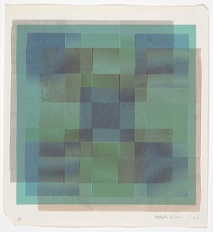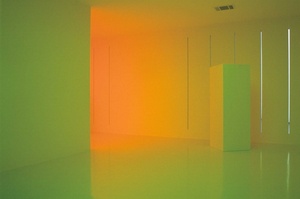If you have never seen the works of Carlos Cruz-Diez, you may be in for a surprise. I was.
 Cruz-Diez is a Venezuelan artist I became aware of last summer, when the first in a series of bilingual books on Latin American artists called Conversaciones (published by Coleccion Patricia Phelps de Cisneros) was released. But looking at art in a book, and looking at art in person are two different things, as we all know.
Cruz-Diez is a Venezuelan artist I became aware of last summer, when the first in a series of bilingual books on Latin American artists called Conversaciones (published by Coleccion Patricia Phelps de Cisneros) was released. But looking at art in a book, and looking at art in person are two different things, as we all know.
On a recent visit to the Museum of Fine Arts in Houston, I was treated to a sneak preview of Carlos Cruz-Diez: Color in Space and Time, an exhibition that will open on Sunday and run through July 4.
I was charmed.
Even though many works had not been hung — they were sitting on the floor instead of occupying a wall — and even though the lights were, mostly, off, the show looked magical.
The young and the young-at-heart will enjoy his playful “color structures,” which change with the viewer’s perspective. They cleverly engage people in a game about the changing nature of color. At the MFAH, there’s also a site-specific installation made of light. And Cruz-Diez made paintings that, until you are close-up, might be a “structure” or might not.
 Though he was born in 1923, this is the first large-scale retrospective of his work, MFAH says.
Though he was born in 1923, this is the first large-scale retrospective of his work, MFAH says.
The operative quote from the curator, Mari Carmen RamÃrez, in the press release is this:
Generally considered in the context of Kinetic Art, the significance of the large body of work produced by Cruz-Diez since the 1950s extends beyond issues of movement, vibration and sheer retinality. From the beginning, Cruz-Diez focused his research and experiments on one critical issue: the investigation of color as a living organism that is in a constant state of transformation. This exhibition aims to show his radical and unprecedented achievements in this area.
In the site-specific work, Chromointerférence (above), visitors will walk into a large white room in which “two planes of color continually undulate in bands projected onto the walls and floor, dissolving the surrounding volumes–including the viewers’ bodies–into color.” I entered, in stocking feet (MFAH will provide booties), and was able to see something of what this will look like.
The show is meant to travel, but I do not believe any other museum has as yet committed. They should. Cruz-Diez is interesting himself, as well as a window on Latin American art.
Photo Credits: Courtesy of MFAH
